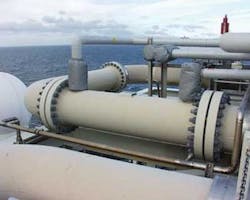Chemical injection technique provides more even distribution
ProScav, ProPure’s compact hydrogen sulfide scavenging technology, now has more than 30 applications worldwide. It is seen as a cost-effective means to reduce the H2S content in hydrocarbon flows to within limits specified by pipeline operators, typically 2.5 ppm.
The search for a means of introducing the scavenger chemical into the hydrocarbon flow to reduce both the costs of the chemical and the footprint of the equipment, began in the late 1990s at Statoil’s urging. As fields age, the incidence of H2S tends to increase, so there is a growing need for efficient technology that can be retrofitted onto installations.
In 2000, ProPure delivered a prototype system to Statoil’s K-Lab, at the Kårstø gas processing plant in western Norway, where it was extensively tested successfully. StatoilHydro since has installed ProScav systems on a dozen of its platforms in the Norwegian sector. Other customers include BP in the UK and Azerbaijan, Maersk in Denmark, PTT in Thailand, Talisman in the UK, and Total in Argentina. Several units have been delivered with a flow metering option built-in.
ProScav incorporates a patented contactor or injection mixer which achieves an even distribution of the scavenger chemical in the hydrocarbon stream, says sales manager Andrés Escalante. The hydrocarbon surface contacted by the chemical is significantly greater than that achieved by conventional injection methods using nozzles or quills. The amount of chemical needed to achieve the required effect can be reduced by 30-40% compared with conventional methods.
For the same reason the system is more compact, with a smaller storage tank, and the environmental impact also is decreased, as a smaller amount of chemical has to be disposed of. Improved environmental performance was among Statoil’s main aims for the new technology, Escalante says.
ProScav also has a high turn-down ratio. If the volume of the hydrocarbon flow is lessened drastically, the geometry of the contactor is such that the injection of chemical can be reduced in proportion without affecting the efficiency of distribution. With a nozzle, once the flow of chemical is reduced beyond a certain point, the atomization efficiency falls.
Another benefit is that the channels in the ProScav contactor are large enough to avoid clogging, a problem which often affects nozzles due to the fine nature of the holes. As contactor parts do not need to be replaced, maintenance is minimized.

